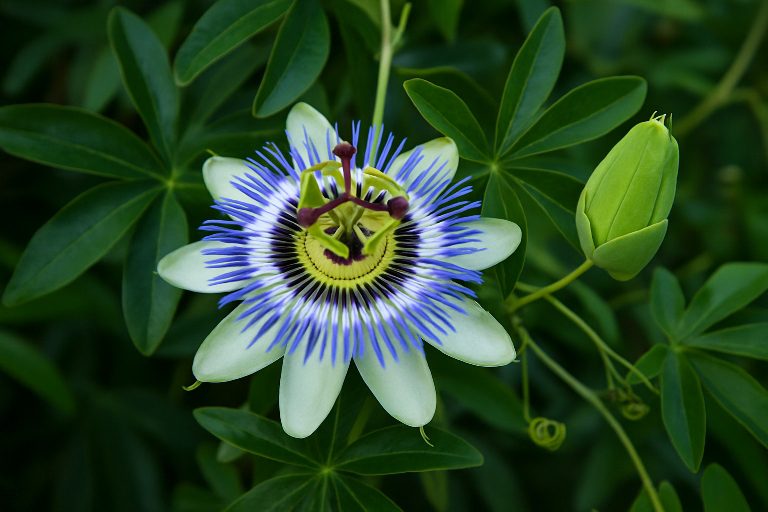Passiflora caerulea (Blue passion flower) is a fast-growing climbing plant in the Passifloraceae family. Its native range extends from Brazil to Argentina in South America. Its enchanting flowers and easy care have made it popular among gardeners.

Key Features
Flowers
The flowers come in three colors: white, blue, and purple. The flower size is about 8-10 cm in diameter. The center of the flower has a spiral design that looks like a crown. This gives it a magnificent appearance.
Leaves
The leaves are green. Each leaf has 5 to 7 lobes (appearing like a pentamerous shape).
Fruits
• The fruits that appear after the flowers are orange in color.
• The fruit is about 6 cm long.
• They are edible, but not very tasty – although they are light and colorful like pink fruits, they are less flavorful.
Fragrance
• The flowers also have a faint sweet aroma.
• This fragrance is most noticeable in the evening.
This makes this plant an all-rounder, not only for its beauty but also for its fragrance and fruit.
READ MORE: Jerusalem Next Year ? Israel’s AI Video Shows Al Aqsa Mosque Demolished
Growth requirements
| Factors | Details |
| Light | Full sun to partial shade (at least 6 hours of sunlight). |
| Soil | Well-drained, pH 6.1-7.5. A sandy/clay mix is best. |
| Water | Water when the soil is dry. Reduce watering in winter. |
| Fertilizer | Slow-release fertilizer (NPK 10-10-10) in spring. |
| Cold hardiness | -15°C. Can be grown in areas like North India. |
Care Tips
Support Structure
This plant is a climbing plant, so it needs support structures such as trellises, wire, or wooden frames/boards to grow up. This will help the plant grow properly and produce more flowers and fruits.
Pruning
The old branches of this plant should be cut off at the end of winter. This is because new flowers only come from new branches. Old branches can be a hindrance to poor growth.
Pest Management
• Pollinators: This plant is visited by pollinators such as butterflies and bees. This is a good thing because it helps in the formation of fruits.
• Insecticide: In case of pests (useless worms, small insects), you can use Neem Oil Spray, a natural insecticide. This will protect the plant.
Toxicity & Safety
Poisonous Parts
The leaves and seeds contain a type of toxic substance called “Cyanogenic Glycosides”. When this substance enters the body, it can cause some toxic effects.
Symptoms
Effects of eating this plant by humans or animals by mistake:
• Vomiting
• Diarrhea
• Dizziness
Sometimes it can be serious.
Precaution
• In homes with small children or pets (cats, dogs), this plant should not be kept in an unmarked place where it can be reached.
• It is safe to grow it in a high place.
• According to the ASPCA (American Society for the Prevention of Cruelty to Animals) – this plant is very dangerous for cats.
Frequently Asked Questions (FAQ)
Can I grow blue passion flower in a container?
• Yes, it can be grown in a 30 cm deep pot. Drainage holes are essential.
Why don’t they flower?
This plant needs full sun or at least partial sunlight. If the light is low, the plant may grow but will not flower.
Where can I buy it in India?
You can buy it from nursery stores. If not, you can buy it online.
Conclusion
Passiflora caerulea (Blue passion flower)
is a plant that combines beauty, fragrance, and biodiversity. However, follow safe growing practices due to its toxicity.















